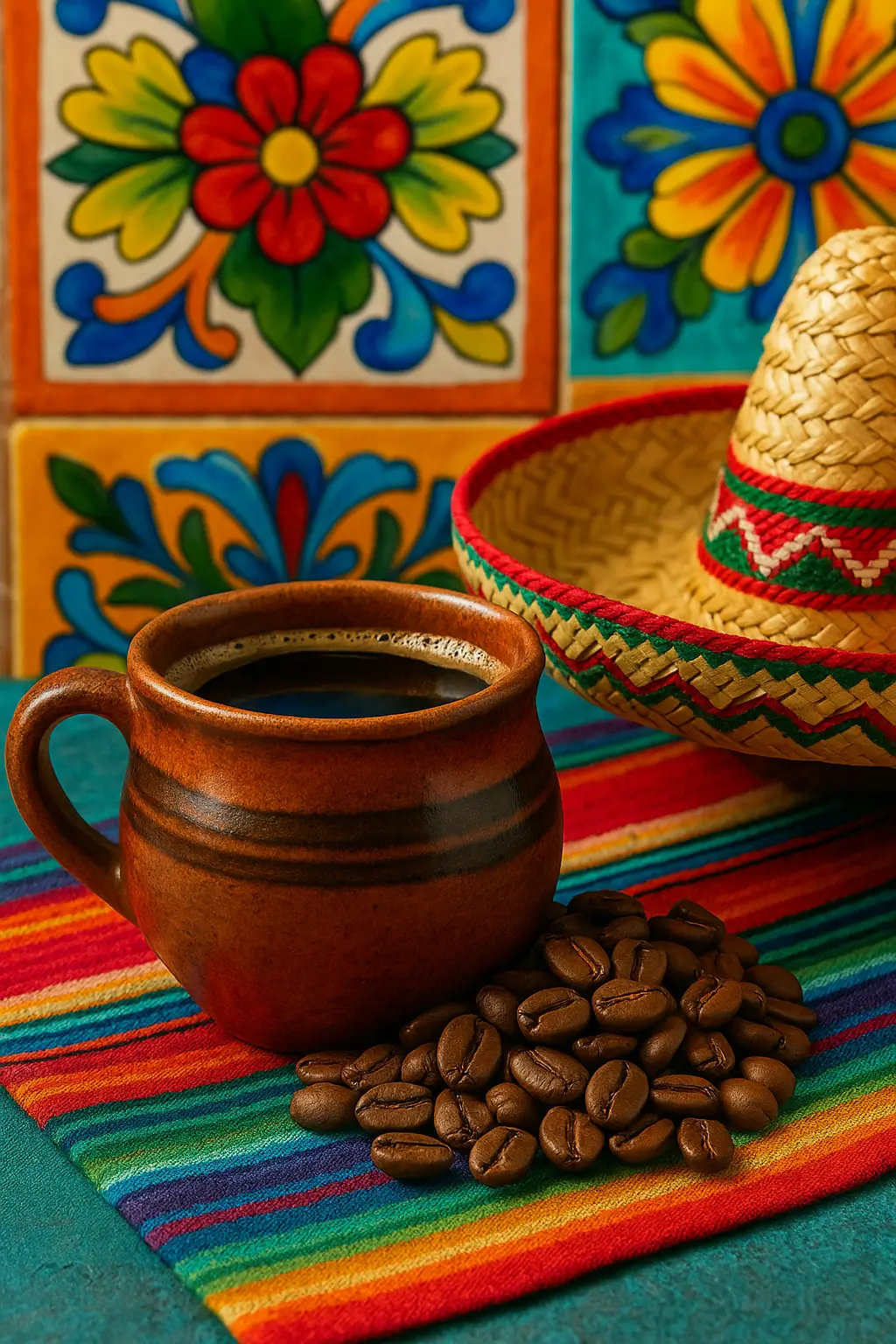Mexican coffee stands out. It gains recognition for its distinct qualities.
This guide explores the world of Mexican coffee. You will learn about its flavor, history, growing regions, and cultural importance.
Mexican coffee beans offer a smooth, easy-drinking experience. They blend nutty, chocolate, and floral notes. This makes them a versatile and distinct choice among coffees. You will understand Mexico’s cherished coffee heritage.
What makes Mexican coffee unique: Flavor and characteristics
Mexican coffee has a light to medium body. It offers a smooth, delicate cup. This creates a balanced, nuanced brew. You often find a mild acidity and pleasant dryness. People compare it to the crispness of white wine. Overall, Mexican coffee is easy to drink. It appeals to many tastes.
The subtle Mexican coffee flavor profile features harmonious notes. These come from carefully grown beans. They create a complex and inviting sensory experience.
- Nutty flavors: You might taste hazelnut or roasted nuts, giving a warm, comforting finish,
- Chocolate notes: These range from subtle cocoa hints to richer, dark chocolate feelings. They are strong in Chiapas coffee,
- Mild acidity and pleasant dryness: The coffee often feels crisp, much like white wine,
- Floral overtones: You notice these especially in coffees from places like Oaxaca coffee. They add elegance and complexity,
- Fruity brightness: Depending on the type of bean and region, you can find citrus, tropical, stone, berry, or orchard fruit notes,
- Subtle sweetness: This tastes like caramel or brown sugar. Sometimes it blends with fruit qualities,
- Buttery texture: Some Mexican coffees have a smooth, velvety feel in your mouth. This makes tasting much richer,
- Subtle spice hints: Occasionally, cinnamon and clove notes add warmth and depth to the flavor.
A journey through time: The history of Mexican coffee cultivation
The history of Mexican coffee cultivation started in the late 1700s. Spanish colonists brought coffee plants to Mexico. These plants came from existing coffee areas like Cuba and the Dominican Republic. Early plantations began in Veracruz. They used indigenous labor to grow the new crop.
By the mid-1800s, coffee grew well in Mexico’s southern climate. This led to a big jump in coffee production. Rich, European-run plantations controlled much of this growth. This often meant taking indigenous land and forcing labor. This expansion built Mexico’s coffee industry. It also created unrest among indigenous people.
The Mexican Revolution began in the early 1900s. It was a key moment for the nation’s coffee. This period started a long process of land reform. Large estates, called haciendas, were broken up. Land then went to indigenous communities and smallholder farmers. This changed land ownership across the country. Labor reforms from this time also freed many indentured servants from coffee farms. They could then grow coffee in their own communities.
By the late 1900s, Mexico’s coffee industry changed a lot. It moved from big plantations to many small, often indigenous-owned farms. The Mexican government helped this shift. It set up the National Coffee Institute of Mexico (INMECAFE) in 1973. This aimed to help the coffee sector grow. Today, indigenous and smallholder producers make up about 85% of all coffee farmers. They remain vital to Mexico’s coffee output. However, they often face economic struggles. They need ongoing support from government and non-profit groups.
In Mexican culture, coffee is more than a farm product. It ties deeply to the identity and money of many indigenous and rural communities. Growing it carries a dual legacy. One is colonial exploitation. The other is revolutionary struggle and land reform that empowered indigenous growers. Today, Mexican coffee earns global praise for its quality. It stands as a core part of Mexico’s rich cultural heritage and rural life.
Mexico’s distinct coffee regions: Terroir and taste
Mexico’s diverse terroir greatly shapes the coffee grown in its regions. Each area has unique microclimates, elevations, soil types, and farming methods. This mix creates the varied flavors in Mexican coffee. This rich diversity means each coffee region offers a signature taste. Its specific environment shapes that taste.
Chiapas: The powerhouse of Mexican coffee
Chiapas is Mexico’s largest coffee producer. It provides over 40% of the nation’s yearly coffee crop. The region has high elevations, volcanic and mineral-rich soils, and plenty of rain. These conditions are perfect for growing coffee. Chiapas grows excellent Arabica beans. They have a smooth, medium body and a bright but balanced acidity.
This coffee is known for its complex flavor. You will find a strong chocolate and cacao aroma. It has a creamy texture and caramel-like sweetness. There are also delicate floral hints. Other features include bright citrus and dried fruit notes. These often come with subtle aromatic bitters. Chiapas coffee is among the best Mexican coffees. This is due to its unique land and amazing flavor complexity.
Puebla: Volcanic complexity in every sip
Puebla, specifically its Sierra Norte region, grows about 15% of Mexico’s coffee. While less known globally than Chiapas or Oaxaca, Puebla’s coffee stands out for its rich, complex flavors. The beans grow at high altitudes near the active Popocatépetl volcano. This gives the region very fertile, nutrient-rich volcanic soil.
Puebla coffees generally have a balanced medium body and moderate acidity. These brews have distinct flavors. You might taste vanilla, bright citrus, warm nutmeg, deep cacao, sweet caramel, and nutty undertones. The high elevation and volcanic impact give Puebla coffee remarkable complexity. Each cup offers a unique experience.
Oaxaca: Subtle elegance and shade-grown traditions
Oaxaca accounts for about 11% of Mexico’s coffee production. Its famous Pluma region contributes a lot. Unlike other regions, Oaxaca’s coffee grows mostly at lower elevations. This results in more subtle, yet complex, flavor profiles. This region focuses on traditional shade-growing techniques. This practice greatly affects the coffee’s distinct taste.
Oaxaca coffee is famous for its lighter acidity, refreshing citrus notes, and creamy body. Common flavors for this region include delicate cacao, sweet caramel, various nuts, and a range of fruits like lime, melon, and berries. Often, you also find elegant floral undertones. Traditional shade-growing methods create an environment that enriches the beans. This makes for a unique and refined cup.
Veracruz: Smooth, mellow, and sustainable
Veracruz sits in volcanic highlands. It has a great environment for growing coffee. The region produces coffee known for its medium body and mellow acidity. It offers a consistently smooth and pleasant drink. Flavor notes in Veracruz coffee typically include nutty and chocolatey undertones. These create its approachable profile.
Notably, Veracruz has a strong name for organic and sustainable coffee farming. Many coffee farms here run as co-ops. They support indigenous farmers. This ensures ethical and eco-friendly production. Veracruz coffee is not as high in volume as Chiapas or Puebla. However, people value it for its quality and dedication to sustainable growing. This makes it a conscious choice for you.
Beyond the bean: Mexican coffee culture and customs
In Mexico, coffee is more than a drink. It is a deep social and cultural ritual. It ties into Mexican culture. This cultural meaning shapes how coffee is made, shared, and enjoyed nationwide. It shows hospitality and national identity. Coffee connects people across generations. It serves as a background for daily talks and celebrations.
Café de Olla: A taste of tradition
Café de Olla is a distinct, historic Mexican coffee tradition. It differs from regular brewed coffee. Its unique making method and ingredients set it apart. This drink slowly simmers or steeps in an olla de barro, a traditional clay pot. It does not go through typical drip or espresso brewing. This simmering lets the coffee fully absorb rich flavors from added spices and sweeteners. The result is a sweet, spicy, and aromatic flavor profile.
Typical ingredients for Café de Olla include dark roasted, coarsely ground coffee. You also add piloncillo, an unrefined cane sugar from Mexico. It gives a deep, caramel-like sweetness. Aromatic cinnamon sticks and strong cloves go in too. Sometimes a hint of star anise adds a subtle licorice note. Its roots go back to the Mexican Revolution. Soldaderas, or female camp followers, made this nourishing and energizing drink for soldiers. Today, Café de Olla remains a cherished and culturally important drink. It is very popular in southern Mexico. People traditionally enjoy it hot, often with breakfast or during celebrations.
Café con Leche: French influence, Mexican hospitality
Café con Leche is another widely loved, traditional Mexican coffee. It mixes strong, fresh coffee with steamed milk, usually in equal parts. People often sweeten this popular drink to taste. It creates a creamy, comforting beverage. Its style came from French influences during colonial times. It shows a historical exchange of food traditions.
Typically, people serve Café con Leche in a tall, thick glass cup. Often, a metal spoon sits inside to stop the glass from cracking when hot coffee pours in. This serving custom adds to its charm and practicality. The drink itself represents Mexican hospitality and social warmth. It is a common offering in homes and eateries across the country.
Coffeehouses as cultural hubs
Coffeehouses, called “cafés” in Mexico, act as vital community spaces across the nation. These places offer more than just a cup of Mexican coffee. They serve as important spots for social gatherings, talks, laughter, and connecting with family and friends. Cafés show the rich social fabric of Mexican communities. They embody a relaxed atmosphere where people can unwind and engage.
Pride in local production
Mexico feels immense pride in its local coffee. This is especially true in southern and central states like Chiapas, Veracruz, Puebla, Oaxaca, and Guerrero. These regions have ideal growing conditions. They yield high-quality Mexican coffee beans. This local production directly boosts Mexico’s national identity. It fuels the growing specialty coffee market. The link between local beans and national identity strengthens the country’s strong coffee heritage. It also supports its artisanal contributions to the global coffee industry.
Mexican coffee regions at a glance
| Region | Key characteristics | Flavor notes |
|---|---|---|
| Chiapas | Mexico’s largest producer, high elevation, volcanic soil | Chocolate, cacao, caramel, floral, citrus, dried fruit |
| Puebla | Sierra Norte, high altitude, volcanic soil (near Popocatépetl) | Vanilla, citrus, nutmeg, cacao, caramel, nutty |
| Oaxaca | Lower elevation, traditional shade-grown | Cacao, caramel, nutty, lime, melon, berries, floral |
| Veracruz | Volcanic highlands, mellow, sustainable, co-ops | Nutty, chocolatey |
Mexican coffee offers a unique and appealing experience. Its distinct flavor profile—nutty, chocolatey, floral—with a smooth, easy balance, sets it apart globally. The rich history of Mexican coffee, from its colonial start to the empowering land reforms after the Mexican Revolution, gives each cup a story of resilience. The diverse coffee regions Mexico has—like Chiapas, Puebla, Oaxaca, and Veracruz—each add their own subtle characteristics. Their unique land and traditional farming methods shape these.
The vibrant Mexican coffee culture, shown by traditions like Café de Olla and Café con Leche, confirms its role as more than just a drink. It is a cherished social ritual. Mexican coffee truly appeals to many coffee drinkers. It offers elegance, versatility, and a deep connection to its heritage. Ready to experience the elegant balance of Mexican coffee? Explore beans from Chiapas, Oaxaca, or Veracruz on your next coffee adventure!









